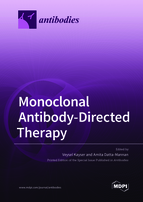Monoclonal Antibody-Directed Therapy
A special issue of Antibodies (ISSN 2073-4468).
Deadline for manuscript submissions: closed (30 September 2020) | Viewed by 76926
Special Issue Editors
Interests: development of vaccines; therapeutic monoclonal antibodies (mAbs); stabilization and formulation of vaccines and mAbs; nanoparticles; protein folding and aggregation
Special Issues, Collections and Topics in MDPI journals
Interests: monoclonal antibodies; ADCs; bispecifics; fusion proteins; antibody engineering; drug disposition; distribution; pharmacokinetics; modeling and simulation; physical–chemical characterization; mechanisms influencing clearance of antibody products
Special Issues, Collections and Topics in MDPI journals
Special Issue Information
Dear Colleagues,
The unparalleled specificity and high efficacy of monoclonal antibodies (mAbs) make them the most desirable products as biological medicines. They are amongst the top-selling drugs globally and their market size continues to grow annually. There are only about 70 mAb products on the market currently, but considering the hundreds that are in clinical trials and the new advancements in this field, such as the development of biosimilars, their market share is expected to increase substantially in the near future.
Over the years, different types of mAb products have been developed, including full-size mAbs, antibody fragments, antibody-drug-conjugates (ADC) and bispecifics, but full-size mAbs still dominate the market. In addition, new approaches such as PEGylation or the hyperglycosylation of constant domains of mAbs and other forms of antibodies such as single domain antibodies (nanobodies) and antibody-targeted nanoparticles have also been frequently explored and they seem to be promising, but these products are yet to receive approvals and reach the market.
The majority of biologics, in particular mAbs, are expensive due to the high costs associated with their development and manufacturing, and thus their similar follow-on counterparts—biosimilars—are expected to be very attractive to many consumers because of their affordability. The development of biosimilars has recently become possible for many blockbuster biologics owing to the loss of their patent protection and updates in regulatory guidelines.
Some of the antibody products are closely related to the reference product, but because they have superior characteristics compared to the former, they are called ‘biobetters’. These next-generation products are not defined well at the moment, but perhaps some existing products such as ADCs, bispecifics, and PEGylated or hyperglycosylated versions of certain products can be called biobetters. Biobetters may display improved efficacy/specificity, bind to more than one target or tackle some commonly observed physical–chemical issues such as protein aggregation. Advances in connecting the mechanisms influencing the disposition and pharmacokinetics of mAb products will continue to augment the discovery and development of antibody products. Immunogenicity and immunogenic potential remains a key space for the optimization of antibody products as therapeutic modalities.
These new developments and other advances such as in silico methods employed to study and/or predict protein–protein interactions, require frequent updates in the literature and necessitates the publishing of a Special Issue journal such as this one. We strongly feel this is a timely commitment and would like to invite researchers from both academia and industry to submit their novel mAb therapy work for this issue in order to capture the new developments that have transpired as well as covering established concepts in this exciting field. In this Special Issue we will consider the following topics: mAb therapeutics, novel forms of antibody products, optimization or mAbs with experimental or computational methods including novel pharmacokinetic modeling and simulation approaches, advances in the pharmacokinetic characterization, disposition, biodistribution and clearance of antibody products, approaches towards immunogenicity prediction/characterization and new topics including but not limited to bispecifics, ADCs, nanobodies and antibody-targeted nanoparticles.
Assoc. Prof. Dr. Veysel Kayser
Dr. Amita Datta-Mannan
Guest Editors
Manuscript Submission Information
Manuscripts should be submitted online at www.mdpi.com by registering and logging in to this website. Once you are registered, click here to go to the submission form. Manuscripts can be submitted until the deadline. All submissions that pass pre-check are peer-reviewed. Accepted papers will be published continuously in the journal (as soon as accepted) and will be listed together on the special issue website. Research articles, review articles as well as short communications are invited. For planned papers, a title and short abstract (about 100 words) can be sent to the Editorial Office for announcement on this website.
Submitted manuscripts should not have been published previously, nor be under consideration for publication elsewhere (except conference proceedings papers). All manuscripts are thoroughly refereed through a single-blind peer-review process. A guide for authors and other relevant information for submission of manuscripts is available on the Instructions for Authors page. Antibodies is an international peer-reviewed open access quarterly journal published by MDPI.
Please visit the Instructions for Authors page before submitting a manuscript. The Article Processing Charge (APC) for publication in this open access journal is 1800 CHF (Swiss Francs). Submitted papers should be well formatted and use good English. Authors may use MDPI's English editing service prior to publication or during author revisions.
Keywords
- Monoclonal antibody (mAb) therapies
- Antibody medicines
- Antibody drug conjugates (ADCs)
- Bispecific and multispecific antibodies
- Next-generation biologics
- Follow-on biologics
- Single-domain antibodies—nanobodies
- Optimization of antibody products
- Formulation of mAbs
- Biosimilars
- Biobetters
- Antibody engineering
- Antibody pharmacokinetics
- Antibody distribution in vivo and in vitro
- Modeling and simulation of antibody clearance
- Physical–chemical characterization of antibody products
- Mechanisms influencing antibody clearance







